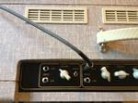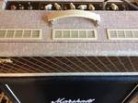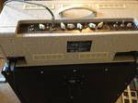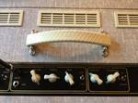The new model is the Vox AC30 HWH. Quite a mouthful but HWH stands for Hand Wired Head. This model does not use a circuit board but goes back to the early days of electronics with turret board design. Throw in the gorgeous white vinyl covering and the familiar tube format and this seems to be only a reissue of an early model. Not so dear readers. What Vox basically did was take the best of the old and update it with a few new tricks. I was surprised how heavy this head is. Birch plywood is used, and in my scientific test of comparing it to a 42 lb. six year old its heavier and more solid feeling.
This is the point in the review when I'm going to admit that I'm a Marshall guy. I like gain, lots of it, being able to EQ bass, mids, and treble, and the rugged construction of Marshall's gear. I also like to get my sound from the amp and not have a bunch of pedals or as few effects as possible added. I don't mind adding chorus, reverb, or other effects to complement the natural sound of an amp. I've always veered away from Vox in the past as their channel two lacked gain and punch. It was OK for jazz and blues but that was about it. That's where this AC30 design changes things and I hope a lot of people give this amp a try for themselves.
Channel one is the familiar 'clean' channel with no EQ. Two inputs (high and low), a volume knob, and something new. Added on this model is a bright switch.
A bright switch on a Vox amp? That's like adding fringe to a leather racing motorcycle outfit, right? Actually, and very welcome, is that channel one has been re voiced darker than previous AC30's I've played. Flip that bright switch and your back in familiar Vox clean territory with all its chime and personality. Channel two has the familiar volume and bass and treble knobs but now there is a new switch labeled 'cool' and 'hot'. Cool is the familiar Vox channel two that didn't satisfy me in the past. Flip to hot and suddenly this amp comes alive. Gain is increased, responsiveness to input comes alive, and overtones fly out of this thing. This is very reminiscent of a Marshall Plexi sound. I added an Overdrive pedal and suddenly I was in JCM800/900 territory. A true EQ section would have been welcome but an EQ pedal will let you tailor your sound to your taste. With no pedals I was very happy with the tones I could achieve.
The biggest improvement to this amp is the addition of a switchable master volume knob. Want to operate in classic Vox style? Switch it off. To increase gain increase your volume. This leads to high volumes for rock tones which isn't good for using at home or small clubs. Switch the master volume knob on and now your channel volumes become gain knobs. Turn them up to your gain preference and control your overall output with the master volume. Many amps got master volumes in the 70's but purists have resisted having things like this added to their favorite classics. On channel one a fat rhythm sound is easy to obtain. Since your not pushing the amp hard it stays clean with little overtone. Lower the channel volume (without losing overall volume) and it cleans up more. Similarly, with channel two you can go from classic rock to a nice thick tone that covers everything from blues to AC/DC style rock. This is a big deal. Formerly Vox was known for only their clean sound, and with the exception of a few rock artists like Brian May, you wouldn't see anyone playing rock with their amps. Another welcome addition is the pentode/triode switch which lets you select 15 watt or 30 watt operation. If you need a thick sound at lower volume use 15 watts - this is especially useful for recording.
If I have one complaint about the AC30 HWH is that the controls are still on the top of the amp. I had the unit on a 4x12 Marshall cab and the controls were still accessible. If you plan to use a full stack you'll need a ladder to get to the controls. I know Vox wants to stay true to their original design but that isn't very functional in today's world with the bigger amp stacks artists use (yes I am crazy enough to run a 30 watt amp through a full stack
I can live without the fact that this amp doesn't have an effects loop. Its great tones beg you not to tie the sound down with a ton of effects. One curiosity left over from the old design is that both channels are always active. I left my channel two volume cranked while using the master volume and plugging into channel one. I had a nice tube hum from a lot of gain even though I wasn't using much on channel one. That was coming over from channel two. I learned you need to zero out the volume on the channel you aren't using which leads me to wonder if you can tie the two channels together with a jumper like many early Marshall designs.
Rather than torture you with my duffer playing here's a link to the Vox site which has some pretty good videos on it:
http://www.voxamps.com/us/handwired/ac15hwac30hw/















